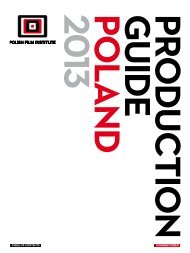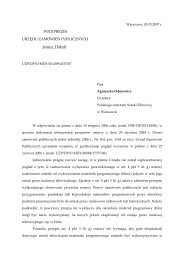Create successful ePaper yourself
Turn your PDF publications into a flip-book with our unique Google optimized e-Paper software.
general Information<br />
Location and area<br />
<strong>Poland</strong> lies in Central Europe, bordered to the north by<br />
the Baltic Sea. The geographic coordinates of <strong>Poland</strong> are<br />
latitudes from 49°00’ to 54°50’ N and longitudes from 14°07’<br />
to 24°08’ E. The geometrical centre of Europe lies in the<br />
vicinity of <strong>Poland</strong>’s capital, Warsaw. Spanning 649 km northto-south<br />
and 689 km east-to-west, <strong>Poland</strong> is also the site of<br />
the geologic division between the eastern and western<br />
European continental blocks. The total land area of <strong>Poland</strong> is<br />
312,685 km 2 , with a territorial sea of 8,700 km 2 and another<br />
1,200 km 2 of the inlets of the Oder (Szczecin) Lagoon and<br />
Vistula Lagoon. In terms of area, <strong>Poland</strong> is the 63 rd largest<br />
country in the world, and the 9 th largest in Europe. The total<br />
length of <strong>Poland</strong>’s borders is 3,582 km, whereof (clockwise<br />
from north): 528 km is the coastline, 210 km borders on the<br />
Russian Federation, 103 km – Lithuania, 416 km – Belarus,<br />
529 km – Ukraine, 539 km – Slovakia, 790 km – the Czech<br />
Republic and 467 km – Germany.<br />
<strong>Poland</strong> is in the Central European Time Zone (GMT+1),<br />
along with a number of European countries, including Spain,<br />
France, Germany, the Netherlands, Italy, Austria, Slovakia<br />
and Hungary. From March to October <strong>Poland</strong> observes<br />
Daylight Saving Time (GMT+2).<br />
FILM PRODUCTION GUIDE POLAND <strong>2009</strong><br />
Topography and Landscape<br />
<strong>Poland</strong> lies in the eastern part of the geomorphological<br />
region of the Northern European Lowlands and thus over<br />
90% of <strong>Poland</strong>’s area is of a lowland nature. The average<br />
altitude is 173 m, with the highest elevation being the Rysy<br />
peak (2,499 m) of the Tatra Mountains and the lowest<br />
depression lying in the northern region of Żuławy Wiślane<br />
(1.8 m below sea level). There are three key mountain chains<br />
in <strong>Poland</strong> – the Carpathian, the Sudeten, and the<br />
Świętokrzyskie (sometimes referred to as the Holy Cross<br />
Mountains). At 1,037 km, Vistula is <strong>Poland</strong>’s longest river.<br />
There are over 9,000 lakes exceeding 1 hectare in size, of<br />
which the deepest are Hańcza (108.5 m), Drawsko, Wielki<br />
Staw Polski, Czarny Staw and Wigry.<br />
The Polish landscape is rather diversified, with a<br />
layered structure of geographical regions. The coastline is<br />
fairly smooth, whereas the coast itself usually flat, with<br />
occasional sand reefs, water inlets, sand dunes, sandy<br />
beaches and also some precipitous cliffs. Northern <strong>Poland</strong><br />
abounds in lakes, with the Vistula river separating them into<br />
two regions – Pojezierze Mazurskie (the plentiful region often<br />
called “The Land of the Great Mazurian Lakes”) in the east<br />
and Pojezierze Pomorskie in the west. The central part of<br />
<strong>Poland</strong> is dominated by the Central Lowlands, with three<br />
distinct regions – Nizina Południowowielkopolska in the<br />
southwest, the Silesian Lowland (Nizina Śląska) in the south<br />
PoLand<br />
9








